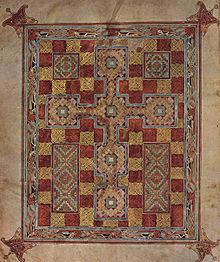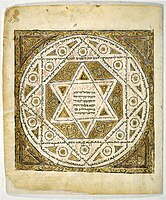Carpet page

A carpet page is a full page in an illuminated manuscript containing intricate, non-figurative, patterned designs.[1] They are a characteristic feature of Insular manuscripts, and typically placed at the beginning of a Gospel Book. Carpet pages are characterised by mainly geometrical ornamentation which may include repeated animal forms. They are distinct from pages devoted to highly decorated historiated initials, though the style of decoration may be very similar.[2]
Carpet pages are characterised by ornamentation with brilliant colors, active lines and complex patterns of
Hebrew Codex Cairensis, from 9th century Galilee
, also contains a similar type of page, but stylistically very different.
Examples
The earliest surviving example is from the early 7th-century
Late Antique decoration. There are notable carpet pages in the Book of Kells, the Lindisfarne Gospels, the Book of Durrow, and other manuscripts.[7]
Carpet pages are also found in some medieval
Qur'ans
, often have pages entirely devoted to complex geometrical decoration, but the term is not usually used of them.
Gallery
-
Early insular example from the Book of Durrow
-
Carpet page from the Book of Kells
-
Page from a Qur'an manuscript, 1182
-
Page from a Qur'an manuscript, c. 1370
-
Page from a Qur'an by Ibn al-Bawwab, 1001 AD
-
Carpet page from the Leningrad Codex
References
Notes
Sources
- Calkins, Robert G. Illuminated Books of the Middle Ages. Ithaca, New York: Cornell University Press, 1983.
- ISBN 978-0-5002-9460-4
Further reading
- Alexander, J.J.G. A Survey of Manuscripts Illuminated in the British Isles: Volume One: Insular Manuscripts from the 6th to the 9th Century. London England: Harvey Miller. 1978.
- Brown, Michelle P. Understanding Illuminated Manuscripts: A Guide to Technical Terms. Malibu, California: The J. Paul Getty Museum. 1994.
- Laing, Lloyd and Jennifer. Art of the Celts: From 700 BC to the Celtic Revival. Singapore: Thames and Hudson. 1992.
- Megaw, Ruth and Vincent. Celtic Art: From its Beginnings to the Book of Kells. New York: Thames and Hudson. 2001.
- Nordenfalk, Carl. Celtic and Anglo-Saxon Painting: Book Illumination in the British Isles. 600-800. New York: George Braziller Publishing. 1977.
- Pacht, Otto. Book Illumination in the Middle Ages. England: Harvey Miller Publishers. 1984.
- Tilghman, Benjamin C. (2017). "Pattern, Process, and the Creation of Meaning in the Lindisfarne Gospels". West 86th. 24 (1): 3–28. doi:10.1086/693796.
External links
- Treasures of early Irish art, 1500 B.C. to 1500 A.D.: from the collections of the National Museum of Ireland, Royal Irish Academy, Trinity College, Dublin, an exhibition catalogue from The Metropolitan Museum of Art (fully available online as PDF), which contains material on carpet pages
- "Sultan Barquq's Qur'an". British Library.
- Howie, Elizabeth. "Dublin, Trinity College MS A.4.5 (57) — Gospel Book (Book of Durrow)". The University of North Carolina at Chapel Hill. Archived from the original on 11 June 2017.
- "Leningrad Carpet Page". West Semitic Research Project. Archived from the original on 2010-11-26.







